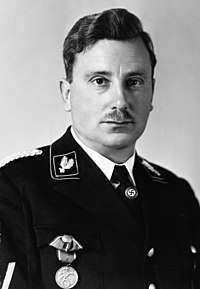Oberführer
Oberführer ([ˈoːbɐ.fyːʀɐ], lit. 'Senior leader') was an early paramilitary rank of the Nazi Party (NSDAP) dating back to 1921. An Oberführer was typically a NSDAP member in charge of a group of paramilitary units in a particular geographical region.[1] From 1921 to 1925, the phrase Oberführer was used as a title in the Sturmabteilung (SA), but became an actual SA rank after 1926.
| Oberführer | |
|---|---|
 SS Gorget patch | |
 SS Shoulder and camo insignia | |
| Country | |
| Service branch | |
| Abbreviation | Oberf |
| NATO rank | OF-5 |
| Formation | 1921 |
| Abolished | 1945 |
| Next higher rank | Brigadeführer |
| Next lower rank | Standartenführer |
| Equivalent ranks | Oberst |

Oberführer was also a rank of the Schutzstaffel (SS, at that time a branch of the SA), established in 1925 as Gauführer, a rank for SS officers in charge of SS personnel in the several Gaue throughout Germany; in 1928 the rank was renamed Oberführer, and used of the commanders of the three regional SS-Oberführerbereiche. In 1930, the SS was reorganized into SS-Gruppen and Brigaden, at which time Oberführer became subordinate to the higher rank of Brigadeführer. By 1932, Oberführer was an established rank of the SA, SS and NSKK.[1][2]
Oberführer wore two oak leaves on the uniform collar rank patch, along with the shoulder boards and lapels of a general officer.[3] In 1938, the status of SS-Oberführer began to change with the rise of the SS-Verfügungstruppe which would later become the Waffen-SS. Since Brigadeführer was rated equal to a Generalmajor, and Standartenführer to an Oberst, Oberführer had no military equivalent and quickly became regarded as a senior colonel rank.[4] This distinction continues in historical circles with most texts referring to Oberführer as a senior colonel rank[4][5] while some others state it has a military equivalent to a British Army brigadier.[6]
Insignia
| Junior Rank Standartenführer |
SS rank and SA rank Oberführer |
Senior Rank Brigadeführer |
See also
- Corps colours (Waffen-SS)
- Table of ranks and insignia of the Waffen-SS
Notes
- McNab 2009b, p. 15.
- McNab 2009, pp. 29, 30.
- Flaherty 2004, p. 148.
- Yerger 1997, p. 235.
- Miller 2006, p. 521.
- McNab 2009, p. 186.
Bibliography
- Flaherty, T. H. (2004) [1988]. The Third Reich: The SS. Time-Life Books, Inc. ISBN 1-84447-073-3.CS1 maint: ref=harv (link)
- McNab, Chris (2009). The SS: 1923–1945. Amber Books Ltd. ISBN 978-1-906626-49-5.CS1 maint: ref=harv (link)
- McNab, Chris (2009b). The Third Reich. Amber Books Ltd. ISBN 978-1-906626-51-8.CS1 maint: ref=harv (link)
- Miller, Michael (2006). Leaders of the SS and German Police, Vol. 1. R. James Bender Publishing. ISBN 93-297-0037-3.CS1 maint: ref=harv (link)
- Yerger, Mark C. (1997). Allgemeine-SS: The Commands, Units and Leaders of the General SS. Schiffer Publishing Ltd. ISBN 0-7643-0145-4.CS1 maint: ref=harv (link)

